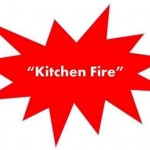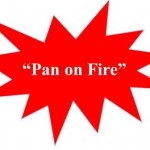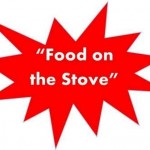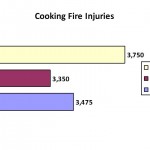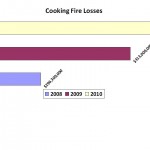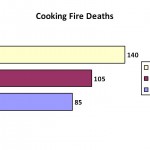Do any these terms sound familiar to you and the people in your department?
I know they sound familiar to me and probably most fire department personnel across our nation and beyond. The unfortunate fact of life is that where there is cooking going on, there is potential for a “stove top fire”.
The National Fire Protection Association, the Federal Emergency Management Agency and many other statistical gathering organizations continue to report that cooking fires are the #1cause of fire in the United States. This is not new “news”: It has been pretty much steadfast over the past 20 years.
As our country continues to “find its way” to a 21st-century economy, we might well expect this trend to continue as many communities see increased development of multi-family dwellings (MFD), a greater percentage of single-family dwellings (SFD) used as rental properties, and a rapidly increasing in senior citizen population living in both SFD and MFD occupancies. Statistically all of these occupancies and populations have been shown to be at a higher risk for the occurrence of cooking fires.
In today’s fiscal climate, every fire department’s budget has been trimmed and trimmed to a point that there definitely is no more “fat”. Even in the “best of times” (fiscally speaking), a fire department that dedicated even 10 percent of its total budget toward fire prevention and education would have been a “statistical outlier.” When the typical fire department’s budget gets cut, fire prevention and public education programs are typically among the first to have their resources slashed or the program is eliminated altogether.
[One definition of insanity: repeatedly doing something that has an undesirable outcome the same way, while expecting a different outcome].
How many times every week do your firefighters respond to the following scenario?
Act 1: Occupant decides to deep fry–using oil or grease–some chicken, fish, or french fries for dinner;
Act 2: While involved in this culinary task, the “cook” gets a phone call or text message, begins a conversation, and wanders away from the kitchen;
Act 3: The next thing they know, they smell smoke—or better yet, hear a smoke detector sounding its alert—and rush to the kitchen only to see a flaming pot on the stove top;
Act 4: The occupant attempts to extinguish the fire by directing water at the fire which in turn splatters the burning liquid and rapidly spreads the fire;
Act 4 (Alternate Action): The occupant grabs the pot from the stove to remove it from the house only to be burned by the flames which causes them to drop the pot which spreads flaming liquid across the kitchen floor;
Act 5 (The Finale): Flames in the kitchen continue to spread, crawling over the ceiling to the adjacent rooms, while everyone hopefully gets out and is calling 911 to get the FD to respond to their “house on fire”.
National Estimates of Residential Building Cooking Fires and Losses by Year
(Click on any of the images to enlarge the view)
The trend is not a good one based on the information and statistics gathered from NIFRS year after year. In my 30 years being in the fire service business, I continue to hear:
- “Well there is nothing we can do about that.”
- “What can be done about people carelessly cooking?”
- “We can’t force people to pay attention while they are cooking.”
- “How can we stop the stove top cooking fire if we are not there?”
All wonderful rationalizations for us to not “think outside the box”, right? Well, I will share some information with you over the next few segments that will convince you that there is something that you and every department in every community can do!
Technology is a wonderful thing! We think of technology as our laptop, desk top, iPad, iPhone, e-reader, and all other modes of info gathering and sharing resources in our daily lives. But technology that helps us do our job needn’t stop there. Thanks to some leading edge design technicians in the private sector, we now have cooking appliance technology that can help us to effectively make cooking fires—particularly those that result from deep frying—a thing of the past. Seriously.
I’m going to share technology with you that has been designed, manufactured, rigorously tested by the appropriate testing agencies, approved and put in the field to make elimination of stove top cooking fires a reality in our lifetime. (The Mayor and City Council of Union City, Georgia, for one, enacted a city-wide ordinance in September 2012 that mandates the use of this technology).
The name for this “silver bullet” is High End Heat-Limiting Technology (HEHLT). Before we get to the tool, let’s take a minute to examine the “chain of events” that results in a stove top cooking fire. Take a look at this picture:

The Progression of a Typical Cooking Fire Resulting from Deep Frying Cooking (Click on image to enlarge)

The Safe-T-Element® device is bolted to the existing burner coils of the range and adds a thermocouple control circuit for each burner. These thermocouple circuits prevent burners from reaching the auto-ignition temperatures of cooking oils (370°C/698°F) or common household cellulose materials (400°C/752°F). There is still plenty of heat available to cook the food (and even blacken it) but unattended cooking can no longer start a kitchen fire.
Now, let’s say that we could provide a simple, yet effective, mechanism to control/limit the highest heat to any of the four heating elements on the stove top so that their temperature would never, ever exceed 668 degrees F. This temperature is sufficient enough to heat oil or grease to a proper temperature for frying, but never enough to reach the 698 degrees F required to for auto-ignition of the cooking oil or grease. That’s exactly what HEHLT does when properly installed.
How about that? No fire to start, no matter how long the person is away from the stove top or how long the oil is heating up. HEHLT is a reality and available to everyone who has an electric coil stove top and its affordable at less than $300 per stove top (four elements). The technology meets code requirements, is installed in over 85,000 homes today, and is recognized by, among others, the International Association of Fire Chiefs and the Department of Defense (DoD). (DoD has mandated the installation of HEHLT in all military residential housing on DoD facilities world-wide).
In our next installment you will learn more about the technology and how your department can become “fully involved” as fire prevention and fire safety activists, without spending large sums of money. By the time we get done, you will have the information and knowledge that you need to start the journey towards the eradication of cooking fires in your community.
So stay tuned!
Translation: As of the effective date of this ordinance (September 18, 2012) all electric coil cooking devices purchased for the purpose of replacement in existing apartment buildings, nursing homes, tax supported housing, or facilities used for residential board and care occupancy or purchased as standard equipment in new apartment buildings, nursing homes, tax-supported housing, or facilities used for residential board and care occupancy shall be equipped with listed and approved high end heat limiting technology.
 Fire & EMS Leader Pro The job of old firefighters is to teach young firefighters how to become old firefighters!
Fire & EMS Leader Pro The job of old firefighters is to teach young firefighters how to become old firefighters!

